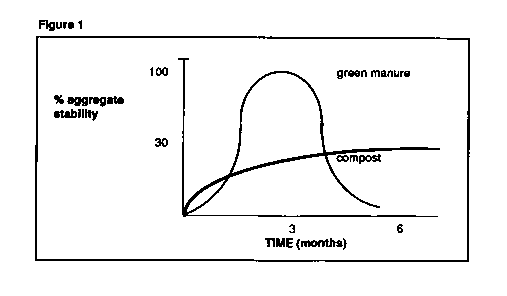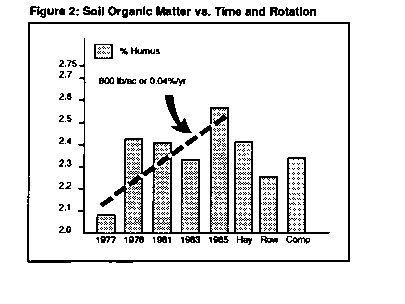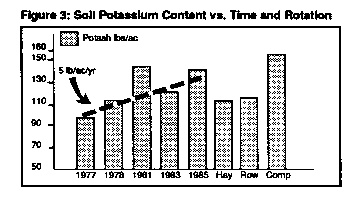
Sustainable Farming Index | Virtual Library | Magazine Rack
Search
| Ecological Solutions Roundtable
by Chantal Foulds
Everything you ever wanted to know about compost but did not know who to ask should have been the title of the conference on the 2nd and 3rd of March in Victoriaville, Quebec. The Centre de Développement d'Agrobiologie du Québec (CDAQ) in conjunction with Le Conseil des Productions Végétales du Québec invited a host of speakers to share their expertise. Among them were Dr. Claude Bourguignon, a soil microbiologist from France; Jacques Petit, a teacher at the Victoriaville Cegep; and Will Brinton, director of the Woods End Institute in Maine.
Bourguignon stressed the need to know what an ideal soil should be when we are determining our soil management practices. When we manipulate fertility, we are feeding the soil, the soil biomass (microbes, etc...) and plants. The nutrient sink in the soil, called the humus-clay complex is composed of, yes you guessed it: clay, organic matter and bonds between these two. The links can be made up of elements such as calcium and sulphur. Out of these three components, organic matter is the easiest to manipulate. Table 1 shows how much organic matter is required to assure soil structural stability and microbial activity at different soil clay contents.
Bourguignon pointed out that everyone was concerned about the loss of organic matter from our soils, but no one was worrying about the loss of clay. it is just as important if not, more important than organic matter in providing surfaces for nutrients to bind to. As well different clays have different nutrient holding capacities.
Several examples were shown where compost had increased the soil microbial activity. One of the more interesting examples demonstrated the negative effects of pig manure and the very positive effect of a hay stand (Table 2).

The inhibitory effect of pig manure was attributed to the fact that antibiotics and Cu and Zn additives used in raising pigs wind up in the manure. These might be toxic to microbes. The high levels of microbial activity under forage stands is explained by the very high root surface area present as compared to row crops. In the corn fields, yields were highest with NPK but Bourguignon was quick to point out that fields not receiving NPK yielded a higher net income for the farmer.
Then the question arises (at least it did for me) what role green manures play versus compost. Green manures have a C/N ratio as low as 7. Microbes quickly devour this, leaving little behind. Compost on the other hand, has a C/N ratio of about 15. This provides a stable reserve of nutrients while increasing soil structural stability (Figure 1). Green manures play an important role in stimulating microbial activity, however they should not be counted on for adding significant amounts of organic matter.
So H composting is so good, what are the key ingredients? Jacques Petit presented an overview of these. As in many things in life, we f ind that there are a lot of "it depends' in the answer. This became the standing joke during the two days of the conference. There are many ways and many materials that can be composted, but the principles remain the same.
Humidity and aeration have to be balanced. A figure of 50% was given as the optimum water content of the material. Manures are much wetter than this and as a result, materials such as straw and/or sawdust must be added. Seven Kg of hay/animal/ day was suggested as the amount required to insure excess water is imbibed and an appropriate C/N ratio. This is not practical for many farmers. Denis La France stated that the "firmness" of the manure itself could be increased by feeding cows a predominantly forage ration. Grain fed livestock tend to produce "wetter"feces, which would require more straw to capture the excess liquids.
On the dry side of manure; sheep, goat and horse excrements often require addition of water for composting success.

An even distribution of humidity and aeration in the heap is important. It is possible to attain this without turning the pile, but a lot of straw is required to insure a suitable structure. In this case, it may be necessary to construct smaller piles. But keep in mind that smaller piles are more susceptible to environmental conditions (drought and storms).
Under ideal conditions, temperatures should reach 70°C. In general, temperatures fall when anaerobic conditions set in. As a result, drops in temperature are used as a guide in determining when to turn the compost. If the compost is not heating up properly, the volume/mass ratio of the heap can be adjusted. That is to say, that by making the heap higher or more spread out, heat will be retained or released Of curse this assumes that all other conditions for a good compost have been fulfilled.
This refers to the ratio of carbon to nitrogen in the plant. Carbon is an energy source for microorganisms and nitrogen compounds are the building blocks for proteins. Microbes consume 20 to 30 times more carbon than nitrogen. As a result, a compost should contain material with a C/N ratio of about 30. Succulent vegetation has a C/N ratio below 30, wood chips a ratio of about 100. That does not mean these materials can not be composted. On livestock farms, seven kg of hay/animal/day is estimated necessary to bring the manure to a C/N ratio of 30. Because this in not always possible, farmers can substitute sawdust for 10-15% of the heap. However, too much sawdust will tie up nitrogen. In addition, sawdust produced from certain tree species have a toxic effect on vegetable crops.
If the C/N ratio is too low, the composting process may be accelerated but nitrogen will be lost. As is often the case, nitrogen is the economically limiting factor on a farm. The other elements are just as important, however they do not pose a risk of limiting production.
The pH of the compost should be neutral. At the beginning of the composting process pH decreases but H the C/N ratio is satisfactory, the pH decrease is only temporary. When materials rich in carbon are used, it may be necessary to add calcitic limestone or dolomitic limestone. However, H high nitrogen containing materials are added to the heap, the addition of lime will only encourage nitrogen losses through volatilization
Will Brinton conducted a study on the effects of composting and rotation on the percent organic matter and potassium levels at Kimberton Farm, a Biodynamic farm in Pennsylvania. He tested several fields over a period of 10 years. The objective was to get a sense of nutrient movement on the farm.
The general trend showed an increase in percent humus of 0.04% (905 kg/ha/year) (Figure 2). There was quite a a lot of variation from 1977 to 1985 but Brinton found this to be a function of what crops were grown in each year. The drastic jump in percent humus in 1978 corresponded to a dramatic change in the rotation. As of that year a larger percentage of the fields were in forage crops.

Previous to 1976, the farm was managed conventionally and the organic matter was below 2%. What is interesting to note is the percent humus per crop over the eight year period. The field receiving compost did not have a higher percent organic matter than the hay fields. It does not suffice to add compost to increase soil organic matter. A rotation which includes forages is just as important a component in the overall plan to increase soil humus.
Brinton also analyzed the fields for potassium (Figure 3). Potassium is a problem on many farms because of its soluble nature. It is especially a problem on organic farms where the availability potassium inputs are virtually non-existent. The general trend on this farm was for potassium to increase 5.7 kg/ha/year as the farm was being converted. If we Wok at the potassium levels per crop we see that all the potassium on the farm had been going to the fields receiving compost manure (ie. corn and vegetable fields).
On this farm, legumes were the basis of nitrogen and soil improvement program. However, a potassium deficiency prevented the forage stand from being used to its full potential for increasing soil organic matter and nitrogen status. By applying compost on forage stands, legumes could be more fully utilized in the soil building process. Corn, which follows hay in the rotation, can only benefit.
Besides showing the results of his studies on the Kimberton Farm, Brinton detailed the steps involved in several composting projects of large volumes of waste: poultry processing waste, poultry carcasses and cull potatoes were all successfully composted.

Other speakers included Marc Hébert (Centre d'Expertise et de Formation en Agriculture Biologique du Québec) and Carol Edmond (Quebec Ministry of the Environment). They summarized a government study which evaluated the economic, agronomic and environmental aspects of composting in dairy production.
Different manure management set ups were compared. In terms of reducing nutrient losses, a scenario in which 5 Kg straw/cow/day, rock phosphate and 1 Kg sawdust cow/day were mixed with the manure before leaving the barn, provided the best results. Labour-wise, a continuous system in which manure is directly laid out in composting heaps from the barn would provide the most savings. Manure would be transported out on a conveyor belt from the barn and transferred to a pivoted conveyor belt that could deposit the manure in semi-circular windrows. If the manure was at the appropriate humidity and C/N ratio, turning the compost pile could even be eliminated. However, this set up can pose environmental risks and is not well adapted to smaller dairy operations.
(Thanks to Aline Grenier for reviewing the articled
Additional Reading Material
For additional information on the studies mentioned in this article, work carried out by the speakers at this conference, or other information on composting write to "Centre de Développement D'Agrobiologie du Québec" (CDAQ), 422, Route Laliberté, Ste-Elizabeth-de-Warwick, Québec, JOA 1 MO. tel: 819-358-5839.
The following books/articles may be ordered from the CDAQ:
Compost, théorie et pratique. J. Petit. L'Oiseau Moqueur. 1988. $13.00
Le compost au jardin. Krafft van Heynitz. Terre Vivante. 1985. S18.00
Biodynamie et compostage. Pfeiffer. Courrier du Livre. 1980. S10.00
Le compost de vers de terra. Jack Temple. Courrier du Livre. 1979. S3.75
Evaluation des fumiers compostés en agriculture. Marc Hébert. CDAQ. 1989. S12.00
Compost 1 et 2. Michel Beaulac. VIDEO. 1989. S22.00
Le compost. Mkhel Mustin. Dubusc. Paris. 1988.
Bio-Dynamic composting on the farm, & how much compost should we use? Blase & Pfeiffer. Bio-dynamic farming & gardening. S3.50.
Compostage. CDAQ. S18.00
Copyright © 1990 REAP Canada
Reprinted with permission. All rights reserved.
Info Request | Services | Become EAP Member | Site Map
Give us your comments about the EAP site
Ecological Agriculture Projects, McGill University (Macdonald
Campus),
Ste-Anne-de-Bellevue, QC, H9X 3V9 Canada
Telephone:
(514)-398-7771
Fax:
(514)-398-7621
Email: info@eap.mcgill.ca
To report problems or otherwise comment on the structure of this site, send mail to the Webmaster